Three big changes have transformed the landscape of Taiwan’s local patronage factions: Increasing Democratic Progressive Party (DPP) involvement, rising new factions and the Chinese Nationalist Party’s (KMT) significantly weakened control.
GREEN FACTIONS
It is said that “south of the Zhuoshui River (濁水溪), there is no blue-green divide,” meaning that from Yunlin County south there is no difference between KMT and DPP politicians.
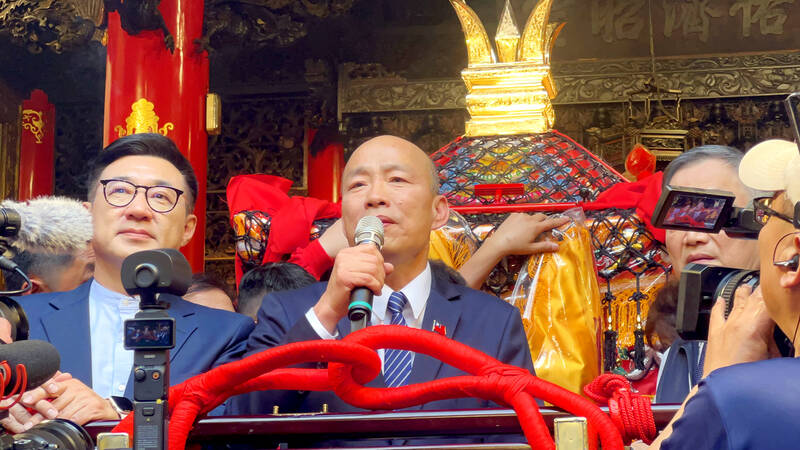
Photo: Liao Yao-tung, Taipei Times
This is not always true, but there is more than a grain of truth to it.
Traditionally, DPP factions are viewed as national entities, with their primary function to secure plum positions in the party and government.
This is not unusual in democracies as politicians often appoint people from their wing of the party or those they have close associations with.
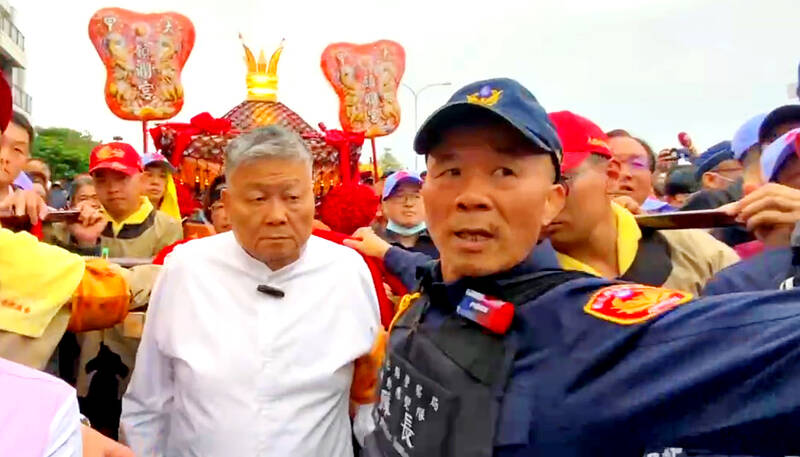
Photo courtesy of a reader
At the local level there are sometimes subfactions that function more like the traditional KMT patronage factions.
In some cases traditional KMT factions switched sides, with the earliest being the Kaohsiung Black Faction around the time of the DPP’s founding, but mostly this happened in the 2000s.
One interesting case is Chiayi County, where the Lin Faction under Chen Ming-wen (陳明文) joined the DPP. Chen went on to help found the DPP’s Ing faction, making it a curious mix of old school KMT factional politicians and technocrats.
The Chen Chu (陳菊) subfaction of the DPP’s New Tide in Kaohsiung is one of the more powerful local factions, and absorbed the Black Faction.
Current Pingtung County Commissioner Chou Chun-mi (周春米) is DPP, but comes from a traditionally KMT faction.
The various Pingtung DPP factions sometimes have bitter infighting locally, but often cooperate nationally and have been dubbed the “Pingtung gang.” They are bitter rivals struggling for control over Taiwan’s agricultural industry and associations with the powerful KMT Yunlin Chang Faction.
During DPP administrations they frequently hold the position of minister of agriculture. Current Secretary-General to the President, Pan Men-an (潘孟安), is a former Pingtung County commissioner.
OLD AND NEW
The most powerful local patronage factions continue to be KMT, with the most famous being the Taichung Red and Black Factions and the Kaohsiung White Faction.
The Kaohsiung White Faction is headed by the still influential former legislative speaker Wang Jin-pyng (王金平). His battles with former President Ma Ying-jeou (馬英九) — who hated the factions — are legendary.
The Taichung Black Faction leader Yen Ching-piao (顏清標) was so powerful he won a legislative seat while serving a prison sentence for corruption, attempted murder and firearms possession. He also seized control of the wealthy Dajia Jenn Lann Matsu Temple, which launches the world’s largest annual Matsu pilgrimage.
His son, current lawmaker Yen Kuan-heng (顏寬恆), has been sentenced to prison for corruption and forgery, but that is still on appeal.
Two of the most powerful factions are newer, starting their careers in the 1990s but rising to dominate the traditional factions this century.
The Yunlin Chang Faction was founded by Chang Jung-wei (張榮味), but without his sister Chang Li-shan (張麗善) this faction would likely not be as powerful as it is, or perhaps not even have survived. In the early days when Chang was forming his faction as county commissioner, he was jailed for corruption, but with his sister leading the charge he was re-elected, and brought others into the faction. She is the current Yunlin County Commissioner.
Chang consolidated control over the Lin faction, and after attracting considerable power he was able to entice former enemies to his side.
The “King of Hualien” Fu Kun-chi’s (傅?萁) story is dramatic and unusual. His family fled the Chinese Civil War and he was born in Taichung.
His father worked for the Taiwan Provincial Government overseeing property developments and was stationed in Hualien. He likely got his hands dirty in property — typical at the time.
This likely gave Fu a base, and he was very successful, making deep inroads into agricultural and irrigation associations as traditional factions did. In time his faction grew to be the most powerful in Hualien.
Fu has served time in prison for insider trading. To get around nepotism rules, he divorced his wife Hsu Chen-wei (徐榛蔚) to appoint her as deputy commissioner, but this was ruled fake by the courts. She is the current Hualien County Commissioner.
TAKING OVER THE KMT
During the Martial Law era, the KMT forced the local factions to limit their actions to their city or county in order to keep them divided and easier to control. Though the factions might have business interests in China, and the Chang family was consolidating power over agricultural organizations at the national level by the 2000s, these were tolerated by the KMT.
Following the landslide 2016 DPP victory, the Act Governing the Settlement of Ill-gotten Properties by Political Parties and Their Affiliate Organizations (政黨及其附隨組織不當取得財產處理條例) was passed, forcing the KMT to give up the vast wealth they had seized from Japanese colonial holdings and other means. This left the party broke.
Party central was weakened significantly, and financial power had shifted to the factions.
In 2014, the DPP had also won landslide victories in local elections, seriously weakening the factions in many localities.
The entire KMT was in crisis.
By 2018, Wang Jin-pyng was working behind the scenes — visiting temples and meeting local politicians — to unite the various factions. Even more groundbreaking, he threw his weight behind Han Kuo-yu (韓國瑜) for Kaohsiung mayor. Han’s wife, Lee Chia-fen (李佳芬), is from Yunlin County and was affiliated with the Chang Faction.
That the Chang Faction would run one of their people outside of Yunlin broke all the traditional rules, and that he was fully backed by the leader of the Kaohsiung White Faction was even more unprecedented.
Wang’s gambit worked, and the KMT won the 2018 local elections in a landslide, with Han as mayor. Han later ran for president and lost, then was ousted as mayor in a recall, but the precedent was set.
This was not fully recognized in the media at the time. There was some coverage of Han’s connection to his wife’s family gravel business, but his connection to the Chang Faction was not yet widely recognized.
Today the Chang Faction not only dominates national agriculture associations. They have one Kaohsiung city councilor and officials serving in various local governments across the country.
Those local leaders know for their future ambitions they will need the support of the Chang Faction.
Han is the current legislative speaker, and the Chang Faction has four lawmakers.
Fu has not spread much influence outside of Hualien, but holds significant power nationally as the KMT legislative caucus whip, setting the party agenda.
Fu is now the most prominent face of the party. Even Han, who is theoretically his senior in the legislature, has joked that it is Fu who is really “big” right now.
Fu is the head of his faction, but Han reports to Chang.
The KMT Party Chair Eric Chu (朱立倫) is not challenging Fu, at least not publicly. The KMT party chair election will likely take place in September, and if Chu wants re-election, he would need the support of Fu and Chang.
Increasingly, Chang and Fu are dominating the KMT in a way the factions never could before. There is talk that the Chang Faction will push for Han to run for president in 2028, and there is speculation he could run for party chair.
Donovan’s Deep Dives is a regular column by Courtney Donovan Smith (石東文) who writes in-depth analysis on everything about Taiwan’s political scene and geopolitics. Donovan is also the central Taiwan correspondent at ICRT FM100 Radio News, co-publisher of Compass Magazine, co-founder Taiwan Report (report.tw) and former chair of the Taichung American Chamber of Commerce. Follow him on X: @donovan_smith.
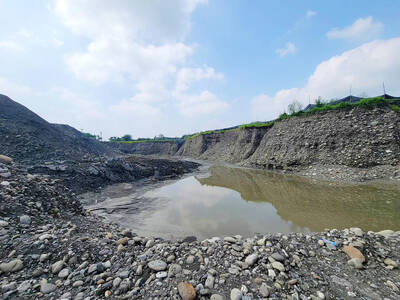
Last week the story of the giant illegal crater dug in Kaohsiung’s Meinong District (美濃) emerged into the public consciousness. The site was used for sand and gravel extraction, and then filled with construction waste. Locals referred to it sardonically as the “Meinong Grand Canyon,” according to media reports, because it was 2 hectares in length and 10 meters deep. The land involved included both state-owned and local farm land. Local media said that the site had generated NT$300 million in profits, against fines of a few million and the loss of some excavators. OFFICIAL CORRUPTION? The site had been seized
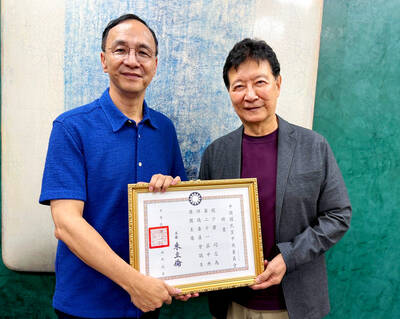
Next week, candidates will officially register to run for chair of the Chinese Nationalist Party (KMT). By the end of Friday, we will know who has registered for the Oct. 18 election. The number of declared candidates has been fluctuating daily. Some candidates registering may be disqualified, so the final list may be in flux for weeks. The list of likely candidates ranges from deep blue to deeper blue to deepest blue, bordering on red (pro-Chinese Communist Party, CCP). Unless current Chairman Eric Chu (朱立倫) can be convinced to run for re-election, the party looks likely to shift towards more hardline
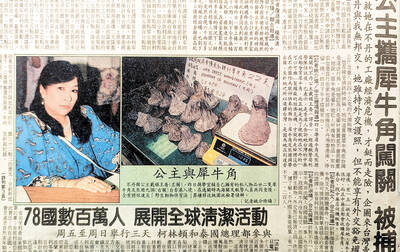
Sept. 15 to Sept. 21 A Bhutanese princess caught at Taoyuan Airport with 22 rhino horns — worth about NT$31 million today — might have been just another curious front-page story. But the Sept. 17, 1993 incident came at a sensitive moment. Taiwan, dubbed “Die-wan” by the British conservationist group Environmental Investigation Agency (EIA), was under international fire for being a major hub for rhino horn. Just 10 days earlier, US secretary of the interior Bruce Babbitt had recommended sanctions against Taiwan for its “failure to end its participation in rhinoceros horn trade.” Even though Taiwan had restricted imports since 1985 and enacted
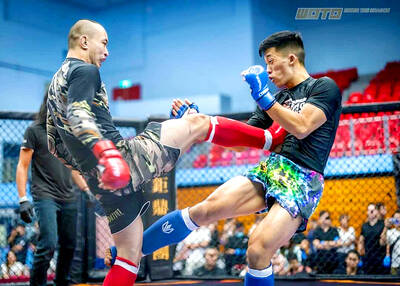
Enter the Dragon 13 will bring Taiwan’s first taste of Dirty Boxing Sunday at Taipei Gymnasium, one highlight of a mixed-rules card blending new formats with traditional MMA. The undercard starts at 10:30am, with the main card beginning at 4pm. Tickets are NT$1,200. Dirty Boxing is a US-born ruleset popularized by fighters Mike Perry and Jon Jones as an alternative to boxing. The format has gained traction overseas, with its inaugural championship streamed free to millions on YouTube, Facebook and Instagram. Taiwan’s version allows punches and elbows with clinch striking, but bans kicks, knees and takedowns. The rules are stricter than the